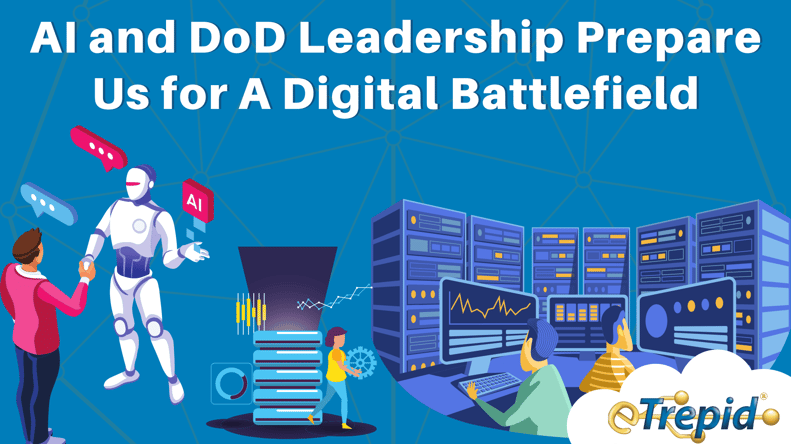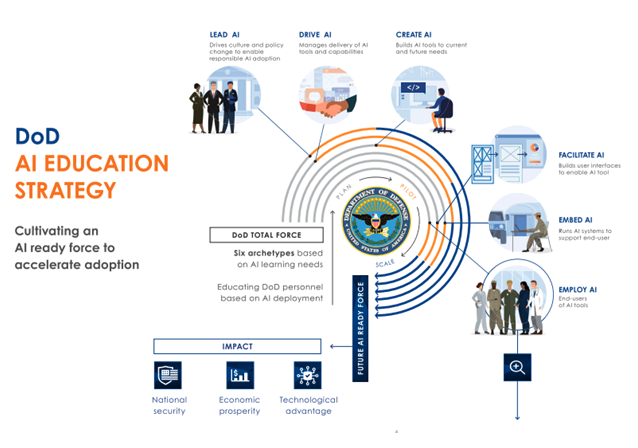Artificial Intelligence and DoD Prepare for Digital Battlefield
Following the National Defense Authorization Act (NDAA) signed by President Biden in December 2021, the Department of Defense (DoD) received an authorization of $770 billion to be distributed across multiple DoD areas of priority. This increase represents a five percent increase in fiscal year spending for 2022 compared to 2021's defense policy measure.

Where are some of these funds going?
Artificial intelligence, machine learning, and the use of data are primary factors of the modernization initiatives of the Department of Defense (DoD) on account of this funding, which has also inspired the creation of new senior executive roles. The aim is to move at par with global digital development and reduce the challenges within. But the main focus of the DoD remains AI.
AI and Machine Learning
The first Chief Technology and Innovation Officer of the United States Space Force, Dr. Lisa Costa, confirms data-driven AI as a primary focus for the DoD serving as one among many cybersecurity digital tools the defense sector can leverage.
Data is crucial for making and maintaining an instantaneous decision advantage, and supporting this capability requires using AI and machine learning technology. Think of it like this: we gather incoming data and use it to act in warfare but at the speed of a digital battlespace instead of a much slower human rate comprehension and interpretation.
AI and machine learning are excellent tools for helping Pentagon officials and warfighters better process and understand significant amounts of data, making it easier to respond, react, or act on intelligent information gathered.
As such, modernization initiatives like the Joint All-Domain Command and Control (JADC2) aim to create a network of increased data sharing and military interoperability by connecting military shooters and sensors across service branches. The success of this initiative relies heavily on AI.
To strengthen the advantage of AI in the DoD, this is what the department plans to accomplish:
- Create a seamless integration of AI into all operations and missions in the DoD
- Use and share award-winning AI research in relevant areas like the adversarial AI
- Define and build the necessary infrastructure to support the functions of the AI initiatives
- Train the workforce and make them AI-ready
- Invest in the best AI and machine learning technology providers

2020 DoD AI Training and Education Strategy
The DoD's Artificial Intelligence Education Strategy is a fascinating read about technological transformation in a global war for top-tier AI talent.
Read DoD's 2020 Artificial Intelligence Education Strategy and contact us to see how we can enhance your company's strategy.
The Need for Technology Leadership in the DoD
The DoD has created senior executive roles to lead in these modernization initiatives, with the most prominent role being that of the Chief Data and Artificial Intelligence Officer (CDAO).
The role of the CDAO is to oversee several of the pre-existing offices, including the Defense Digital Service (DDS), the Chief Data Officer (CDA), and the Joint Artificial Intelligence Center (JAIC). This leadership aims to ensure the DoD has the necessary tools to succeed and keep the innovative interests of defense progressive.
The CDAO is equally responsible for consolidating the current separation of DoD's AI efforts and data among different institutions. This convergence happens by creating an AI hub with structured coordination, which, in turn, should enhance the position of the United States among leaders in emerging defense technologies.
This united front also ensures DoD maintains its focus so that the DDS and the JAIC excel within and outside the enormous defense bureaucracy.
Why Consolidate Data and AI?
Currently, DoD data is difficult to use because it is noisy and unlabeled. Following the adaptation of these new technologies, experimentation is necessary to fully take advantage of their capabilities, and by consolidating the different defense departments, their conjoined efforts will enhance the capabilities of the DoD.
- Data management and coordination across the entire department is the responsibility of the CDO.
- The JAIC assists the DoD in implementing and using AI in the DoD.
- The DDS is a team designated to handle any security or data issues.
As you can see, each of these separate entities controls a specific piece of the data. By combining efforts, DoD positions itself for better decision-making for an effective defense, now and in the future.
Artificial intelligence requires data preparation, management, and development, through training algorithms as achieved by machine learning. By integrating these different departments, AI can be successfully adopted and shared following consistent data mining and preparation.
Here's an example:
The JAIC has worked on several projects regarding emerging technologies in the DoD. However, the department faces the challenge of choosing between helping the military services determine how to develop algorithms within the military programs and implementing them or becoming a body for algorithm development in itself.
Additionally, the lack of a consolidated authority figure makes collaboration between the JAIC, military services, and other defense institutions challenging. But with the emergence of the CDAO, AI hubs and DoD data can work in tandem to give the machine learning DoD algorithms better access to succeed.
As a result, it becomes much easier for the DoD to fully implement the Data Directive to maximize data availability and make it accessible to the DoD. This type of access allows the DoD to understand itself, thus, providing the necessary insight needed to become more effective.
The more the CDAO consolidates and streamlines the various data streams into one central hub, the easier it will be for the defense to use and share data to enhance performance.
The Practical Uses of AI and Machine Learning In the Military
The DoD funding is continually used to enhance the intelligence, surveillance, and reconnaissance processes within the DoD. The breakdown and exploitation of the information gathered is better used to meet and mitigate new threats or any emerging capabilities needed for a proper defense.
For instance, with funding, developing, and deploying the latest defense software is possible. Once the DoD trains and equips the defense team, the defense capacity becomes highly effective.
Additionally, information and networking for collaborative decision-making are possible because of the support of basic research that enables intelligence systems to automatically explore and use machine learning strategies.
The DoD gets a better tactical edge in performance with innovative sensors integrated into the AI algorithms and machine learning tools.


.png)
Leave A Comment